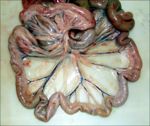Difference between revisions of "Jejunum - Anatomy & Physiology"
Jump to navigation
Jump to search
Fiorecastro (talk | contribs) |
|||
| (70 intermediate revisions by 10 users not shown) | |||
| Line 1: | Line 1: | ||
| − | + | <big><center>[[Alimentary - Anatomy & Physiology|'''BACK TO ALIMENTARY - ANATOMY & PHYSIOLOGY''']]</center></big><big><center> | |
| + | [[Small Intestine - Anatomy & Physiology|'''BACK TO SMALL INTESTINE - ANATOMY AND PHYSIOLOGY]]</center></big> | ||
| + | |||
| + | |||
==Introduction== | ==Introduction== | ||
| − | |||
==Structure== | ==Structure== | ||
| − | [[Image:jejunumphoto.jpg|thumb|right| | + | [[Image:jejunumphoto.jpg|thumb|right|150px|Jejunum(Dog) - Copywright RVC 2008]] |
| + | *The jejunum is the longest part of the small intestine. | ||
| + | *It is highly coiled and occupies the ventral part of the abdominal cavity, filling those parts that are not occupied by other viscera. This produces species variation (see comparative aspects). | ||
| + | *It is suspended by the mesentry (mesojejunum). This conveys the blood vessels and nerves and houses lymph nodes. | ||
| + | **The mesentry converges to its root. This is where the cranial mesenteric artery branches off from the aorta. | ||
| − | + | ==Function== | |
| + | |||
| + | *Has digestive and absorptive functions. | ||
==Vasculature== | ==Vasculature== | ||
| − | The cranial mesenteric artery, a branch of the abdominal aorta, supplies blood to the jejunum, [[Ileum - Anatomy & Physiology|ileum]], | + | *The cranial mesenteric artery, a branch of the abdominal aorta, supplies blood to the jejunum, [[Ileum - Anatomy & Physiology|ileum]], caecum, ascending colon and part of the transverse colon. |
| + | *It branches greatly within the mesenty of the jejunum. | ||
| + | **There are many anastomoses within the mesentry, which ensure that the intestine can survive even if a major division of the cranial mesenteric is damaged. | ||
| + | *The cranial mesenteric vein drains blood from the jejunum and enters the portal vein. | ||
| + | **It is rich in the products of digestion following a meal. | ||
| + | **The portal vein enters the [[Liver - Anatomy & Physiology|liver]]. | ||
| − | == | + | ==Innervation== |
| − | |||
| − | === | + | ==Lymphatics== |
| − | |||
| − | |||
| − | |||
| − | === | + | ==Histology== |
| − | |||
| − | |||
| − | |||
| − | == | + | ==Species Differences== |
| − | |||
| − | + | ==Links== | |
| − | |||
| − | |||
| − | |||
| − | |||
| − | |||
| − | |||
| − | |||
| − | |||
| − | |||
| − | |||
| − | |||
Revision as of 14:55, 10 July 2008
Introduction
Structure
- The jejunum is the longest part of the small intestine.
- It is highly coiled and occupies the ventral part of the abdominal cavity, filling those parts that are not occupied by other viscera. This produces species variation (see comparative aspects).
- It is suspended by the mesentry (mesojejunum). This conveys the blood vessels and nerves and houses lymph nodes.
- The mesentry converges to its root. This is where the cranial mesenteric artery branches off from the aorta.
Function
- Has digestive and absorptive functions.
Vasculature
- The cranial mesenteric artery, a branch of the abdominal aorta, supplies blood to the jejunum, ileum, caecum, ascending colon and part of the transverse colon.
- It branches greatly within the mesenty of the jejunum.
- There are many anastomoses within the mesentry, which ensure that the intestine can survive even if a major division of the cranial mesenteric is damaged.
- The cranial mesenteric vein drains blood from the jejunum and enters the portal vein.
- It is rich in the products of digestion following a meal.
- The portal vein enters the liver.
